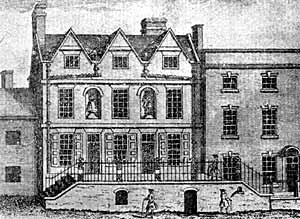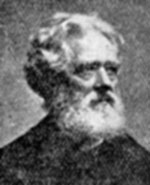THE CHARITY SCHOOL.

The Blue Coat School.
The most eastern building in the Weekday Cross area is that which is partly occupied as the Archdeaconry Offices, which is situated opposite Garner's Hill. This was formerly the site of the "Charity" or "Bluecoat" School—not to be confounded with the "Free" or "Grammar" School. It was occupied from about 1723 until its removal to its present location on Mansfield Road in 1853. Parenthetically it should be stated that the location of the school, from 1706 to 1723, has not been determined by students of local history.
Thomas Sandby in his sketch of the locality, taken in 1741, gives a small perspective view of this building, and Deering a front elevation in his well known history of Nottingham.
This building was of three gables, with dormer windows, and three on each of the two lower storeys. Over each of the two doorways, in niches, were the two statues of a boy and a girl in the costume of the school, which were transferred to the present building. The building was approached by sets of steps at each end of the railed platform landing. It occupied the whole of the site frontage. The schoolhouse is depicted in Deering. Orange informs us that the school premises consisted of "a house, containing two schoolrooms, and apartments for a schoolmaster and his wife, who is the schoolmistress, and a yard behind."
Built into the front of the school about 1755, or later, was a stone tablet with this inscription incised :—
"Blue Coat Charity School, Founded A.D. 1706, by voluntary contributions, and further endowed with land and tenements by Charles Harvey, A.D. 1711, Jonathan Labray, 1718, William Thorp, A.D. 1720, Gilbert Beresford, A.D. 1747, Joseph Peake, A.D. 1755." This was removed, in 1853, from the schoolhouse on the High Pavement to the present Building. Deering stated that in the early part of the 18th century, tho school was "maintained by the voluntary contributions of several worthy gentlemen and substantial tradesmen of this town, for the instruction of fifty poor children in the principles of religion, spelling and reading. Forty of these are clothed in blue."
In 1788 there was a division among the supporters of the Charity School which resulted in the foundation of "The Unitarian Charity School" in the High Pavement Chapel, for the education of thirty boys and twenty-four girls, about half of whom were clothed; with Mr. John Malbon as Master.
An elaborate series of "Rules and Orders" were published in 1793. These relate to the number of scholars, their clothing, mode of election, conditions of admission, the qualifications and duties of the master and mistress, the duties of parents in respect to the scholars, &c. They are informative and interesting, but too lengthy for use here and now.
The projecting steps of the school were removed in 1804. Beneath these was found a brass plate. This bore the following inscription:—" Nottingham Charity School, founded in 1706, and supported by the contributions of the Corporation and others, and was in 1723 removed to this building, which was erected for the use of, and benefit of such school, at the charge of many benefactors, in and nigh this town, upon a piece of ground given by Mr. William Thorpe for that purpose."
The Charity Commissioners reported on this trust in 1828.
To quote Bailey, "the ancient school-house and premises on the High Pavement being utterly devoid of any recreation ground for the children of the institution, as well as of almost every other convenience for advantageously and comfortably carrying on the education and and training of a considerable number of children, it was resolved at a meeting of Trustees in 1852, to dispose of the premises and erect others of a more suitable character, on a piece of ground, in a fine, open, airy situation on the Mansfield Road, which had been obtained by exchange for a small field belonging to the charity, left under the will of Gilbert Beresford (in 1747), which edifice and arrangements have been completed at a cost of about £2,000."1
The following is an abstract of Conveyance, in 1720, of the site for the Bluecoat School located in that portion of Weekday Cross, then known as the High Pavement. This has been kindly prepared by Mr. F. A. Wadsworth for me.
"20th. Decr. 1720. BY INDENTURE of Bargain and sale enrolled in the Court of Chancery between William Thorpe of the Town of Nottingham, Gent., of the one part, and John Plumtre, Esquire, Francis Newdigate, Esq., Heyrick Athorpe, Esq., Thomas Smith, Esq., Samuel Berdmore, Clerk, Timothy Fenton, Clerk, John Abson, Clerk, William Jackson, William Drury, John Town, Philip Launder, Mathew Hoyland, Benjamin Beilby, and John Else, Gentleman, of the other part the said William Thorpe in Consideration of the sum of 5 shillings to him paid by Plumtre and others DID grant (&c.) ALL that Messuage, Cottage, or Tenement, situate in the Town of Nottingham In a certain Street there called Middle pavement on the East or South East side of a certain Messuage belonging to Edmund Whitacre and all that piece of Ground, yard, or garden belonging to the same between the Lands of Mrs. Elizabeth Thorpe, Widow, on the East or South East and the sd. Messuages with the Lands of the said Edmund Whitacre on the West or North West which said Premises contained in the front 39 feet, the Middle 14.10. and at the upper end 6 feet and in length 79 feet and Two Inches and all that Arch and the ground under it lying next the said Street Southward and containing in in Length 37 feet and in Breadth 8 feet All which said Premises were formerly the Estate of George Woodward and were then in the Tenure of William Thorpe and Walter Hornbukle TO HOLD unto and to the use and behoofe of the said John Plumtre, Francis Newdigate, Herick Athorpe, Thomas Smith, Samuel Berdmore, Timothy Fenton, John Abson, William Jackson, William Drury, John Town, Philip Launder, Mathew Hoyland, Benjamin Beilby, and John Else their heirs and aforesaid for ever."
AUTHOR OF "FESTUS".
 P. J Bailey (1816-1902)
P. J Bailey (1816-1902)On the south wall of Holland & Webb's warehouse (the west limit of "Weekday Cross"), has been placed a Holbrook Bequest Memorial tablet of white marble, enclosed in a metal frame, on which is incised, in five lines of sans serif letters, these words:—
ON THIS SITE
STOOD THE HOUSE IN WHICH
PHILIP JAMES BAILEY,
AUTHOR OF "FESTUS,"
WAS BORN APRIL 22nd. 1816.
This building was the residence of the poet's grandfather, Mr. Philip Bailey. He was the "Keeper of the Town Jail," from 1800 to 1820. The house was demolished several years ago to make way for commercial purposes.
(1) The scheme for the Charity School was formulated in 1706. The Common Council was approached by Messrs. Jenner and Clark, who sought that body's financial support for the school in the event of "the setting up and founding a Charity School in the towne of Nottingham, for the bringing up and educating of poor children." The Council resolved "That the Chamberlains for the time being do allow five pounds per annum to be paid as other subscriptions are, during the pleasure of the Council." As the early history of the school does not come within the scope of this paper it is not further mentioned, interesting as it is. The Common Council, September 11th, 1724, "ordered that this Corporation do pay £5 in arrear to the Charity School, and £5 a year for the future, during pleasure provided that this Corporation may have the priviledge of nominating a boy and a girl yearly into the said school."
